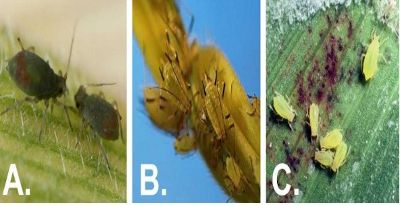By Adam Varenhorst
Reports of aphid populations in wheat fields have been slowly increasing in the past week. Most of these populations are well below the economic threshold, but there is a potential for them to increase. In addition, some wheat has shown signs of greenbug feeding, which is relatively uncommon in South Dakota. Initial greenbug feeding is accompanied by small yellow-orange spots with dark necrotic lesions in the center that appear on infested leaves. If feeding continues, leaves may turn yellow to reddish-brown and will eventually die. So far, the most commonly observed aphids are the English grain aphid and bird cherry-oat aphids. Greenbugs do not overwinter in South Dakota and migrate from the Southern U.S. each the spring.
Aphid Identification
- Bird Cherry Oat Aphid: Bird cherry oat aphids can vary in color from olive to dark green and can be identified by the characteristic burnt red-orange patch that is present on the end of the abdomen near the cornicles or “tailpipes” (Figure 1-A).
- English Grain Aphid: English grain aphids can vary in color from light or dark green to brown, and can be identified by their characteristic black antennae, cornicles, and leg joints (Figure 1-B).
- Greenbug: Greenbugs are a species of aphids that are light green in color and can be identified by the dark green stripe present on their back. Feeding by this species causes yellow discoloration and red spots on the leaves, due to a toxin present in its saliva (Figure 1-C).

Figure 1. (A) Bird cherry oat aphids. Courtesy: Adam Sisson, Iowa State University, Bugwood.org. (B) English grain aphid. Courtesy: Adam Varenhorst. (C) Greenbug.
Scouting Wheat for Aphids
The easiest way to scout for wheat aphid populations is to start at one side of the field and walk in a “W” of zig-zag pattern. While walking the pattern, randomly choose twenty plants from each leg and examine for aphids. During the spring, the aphids are most commonly observed on the leaves and stems of the plants. Table 1 contains the economic thresholds for the three aphid species. If populations exceed the thresholds, please refer the most-current edition of the South Dakota Pest management Guide: Wheat for insecticides labeled for these pests. The forecasted temperatures for the next week will be favorable for aphid development in wheat.
TABLE 1. ECONOMIC THRESHOLDS FOR APHID PESTS OF WHEAT.
| Number of Aphids Per Plant |
|---|
| Pest | Seedling
Stage | Boot to
Heading Stage | Flowering
Stage | Milky
Ripe Stage | Milk to Medium
Dough Stage |
| Bird cherry oat aphid | 20 | 30 | >5 | 10 | >10 |
| English grain aphid | 30 | 50 | 5 | 10 | >10 |
| Greenbug | 5-15 | 25 | >25 | >25 | >25 |
Source : sdstate.edu